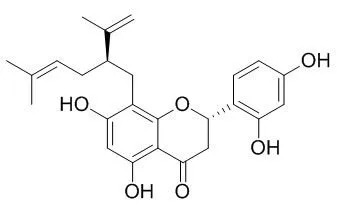| In vitro: |
| Anaerobe. 2013 Feb;19:17-21. | | Antimicrobial effect of sophoraflavanone G isolated from Sophora flavescens against mutans streptococci.[Pubmed: 23178373] |
METHODS AND RESULTS:
In this study, the antibacterial properties of Sophoraflavanone G isolated from the methanol extract of Sophora flavescens were tested against 16 strains of mutans streptococci to screen and determine the optimal concentration of anti-caries natural extract.
The antimicrobial activity was evaluated by measuring minimum bactericidal concentration (MBC). The cell viability of normal human gingival fibroblast (NHGF) cells was tested using the methyl thiazolyl tetrazolium assay after exposure to Sophoraflavanone G. The data showed that Sophoraflavanone G had a remarkable antimicrobial effect on the bacteria tested with an MBC ranging from 0.5 μg/ml to 4 μg/ml. Sophoraflavanone G had no cytotoxic effect on NHGF cells at concentrations where it produced an antimicrobial effect.
CONCLUSIONS:
These findings demonstrate that Sophoraflavanone G has strong antimicrobial activity against mutans streptococci and could be useful in the development of novel oral hygiene products, such as a gargle solution or dentifrice. | | Phytother Res. 2009 Sep;23(9):1326-31. | | Antibacterial activity of sophoraflavanone G isolated from the roots of Sophora flavescens against methicillin-resistant Staphylococcus aureus.[Pubmed: 19288534] |
METHODS AND RESULTS:
In this study, Sophoraflavanone G obtained from Sophora flavescens was evaluated against 10 clinical isolates of methicillin-resistant Staphylococcus aureus (MRSA), either alone or in combination with ampicillin or oxacillin, via checkerboard assay. At the end point of an optically clear well, the minimum inhibitory concentrations (MICs) ranged from 0.5 to 8 microg/ml for Sophoraflavanone G, from 64 to 1024 microg/ml for ampicillin, and from 256 to 1024 microg/ml for oxacillin. The combination of Sophoraflavanone G and ampicillin or oxacillin yielded a fractional inhibitory concentration index ranging from 0.188 to 0.375, thereby indicating a principally synergistic effect. The synergistic interaction was verified by time-kill studies using Sophoraflavanone G and/or antibiotics. Thirty minutes of treatment with Sophoraflavanone G with ampicillin or oxacillin resulted in an increase in the rate of killing in units of CFU/ml to a greater degree than was observed with Sophoraflavanone G alone.
CONCLUSIONS:
These findings indicated that the application of the tested Sophoraflavanone G alone or in combination with antibiotics might prove useful in the control and treatment of MRSA infections. | | Am J Chin Med . 2016;44(1):165-76. | | Sophoraflavanone G Induces Apoptosis in Human Leukemia Cells and Blocks MAPK Activation[Pubmed: 26916921] | | Abstract
Sophoraflavanone G (SG) was isolated from Sophora flavescens. Previously, we have found that SG is able to suppress the inflammatory response in lipopolysaccharide-stimulated RAW 264.7 macrophages. This study aimed to evaluate the effects of SG on apoptosis, and explore its molecular mechanism in human leukemia HL-60 cells. HL-60 cells were treated with various concentrations of SG (3-30 [Formula: see text]M). The viability of the HL-60 cells was assessed using the MTT method, and the nuclear condensation indicative of apoptosis was observed by DAPI fluorescence staining. In addition, apoptotic signal proteins were examined using Western blotting. The results showed that apoptosis, including DNA fragmentation and nuclear condensation, increased significantly in SG-treated HL-60 cells. SG activated caspase-3 and caspase-9, and downregulated Bcl-2 and Bcl-xL. SG also upregulated Bax and released cytochrome c from the mitochondria into the cytoplasm, enabling apoptosis via the mitochondrially-mediated "intrinsic" pathway. Additionally, SG was able to cleave poly (ADP-ribose) polymerase 1 and activate mitogen-activated protein kinase (MAPK) pathways. These results suggest that SG might increase the effect of apoptosis on HL-60 cells through caspase-3 activation, mitochondrial-mediated pathways, and the MAPK pathway. | | Phytomedicine . 2019 Aug;61:152852. | | Sophoraflavanone G from Sophora flavescens induces apoptosis in triple-negative breast cancer cells[Pubmed: 31035052] | | Abstract
Background: A compound isolated from Sophora flavescens-Sophoraflavanone G (SG)-showed anti-tumor and anti-inflammatory properties. We previously demonstrated that SG promoted apoptosis in human leukemia HL-60 cells. In the present study, we investigated the effects of SG on apoptosis in human breast cancer MDA-MB-231 cells, and explored the underlying molecular mechanisms.
Methods: MDA-MB-231 cells were treated with various SG concentrations, and cell viability was evaluated by MTT assay. Apoptotic signal proteins were detected by western blotting, and cell apoptosis was assessed using flow cytometry.
Results: Our results demonstrated that SG induced nuclear condensation, DNA fragmentation, reactive oxygen species production, and increased cell apoptosis in MDA-MB-231 cells. SG also suppressed migration and invasion, likely via blockage of the MAPK pathway. In the apoptotic signaling pathway, SG increased cleaved caspase-8, caspase-3, and caspase-9. SG treatment also decreased Bcl-2 and Bcl-xL expression, increased Bax expression, and prompted release of more cytochrome c from mitochondria to the cytoplasm in MDA-MB-231 cells.
Conclusion: Overall, our findings suggest that SG might increase apoptosis, and decrease migration and invasion, in MDA-MB-231 cells through suppression of a MAPK-related pathway.
Keywords: Apoptosis; Caspase-3; MDA-MB-231 cells; Sophoraflavanone G. |
|






 Cell. 2018 Jan 11;172(1-2):249-261.e12. doi: 10.1016/j.cell.2017.12.019.IF=36.216(2019)
Cell. 2018 Jan 11;172(1-2):249-261.e12. doi: 10.1016/j.cell.2017.12.019.IF=36.216(2019) Cell Metab. 2020 Mar 3;31(3):534-548.e5. doi: 10.1016/j.cmet.2020.01.002.IF=22.415(2019)
Cell Metab. 2020 Mar 3;31(3):534-548.e5. doi: 10.1016/j.cmet.2020.01.002.IF=22.415(2019) Mol Cell. 2017 Nov 16;68(4):673-685.e6. doi: 10.1016/j.molcel.2017.10.022.IF=14.548(2019)
Mol Cell. 2017 Nov 16;68(4):673-685.e6. doi: 10.1016/j.molcel.2017.10.022.IF=14.548(2019)